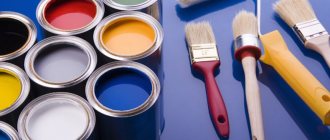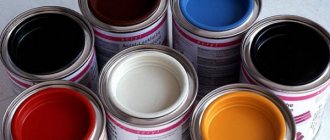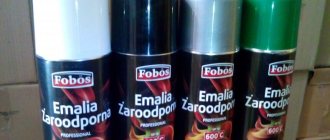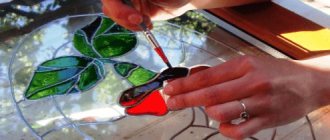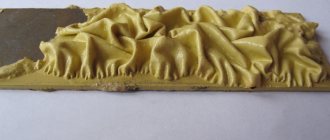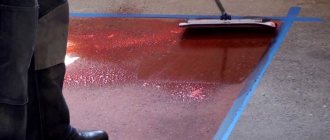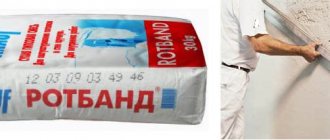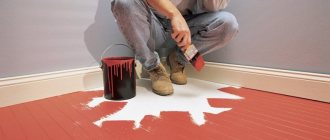Today, a wide range of finishing materials is used to carry out repair work on various surfaces in the room. Various manufacturers provide the consumer with a large number of paint and varnish products, which makes it possible to easily purchase an acceptable option for a specific surface. Enamel compositions, slightly different from standard paints and varnishes, have become very popular for finishing walls and ceilings.
Many people quite often ask the question: “What is the difference between enamel and paint?” - however, even the most experienced professionals who work with paints and varnishes are not always able to answer accurately.
Some people believe that enamel is the same as ordinary enamel paint. Others suggest that the difference between this material and standard paintwork is that the first is shiny, and the second is matte. Of course, this opinion is wrong. Despite the apparent similarity of characteristics, there are much more significant differences between these definitions such as “paint”, “enamel” and “enamel paint” than the presence or absence of a shiny shade.
What is the difference between oil paint and enamel: comparison table
June 21, 2021
Read later
We will send the material by email
When performing finishing work inside or outside a building, various coloring agents are often used. They are simply irreplaceable when decorating ceilings, walls, and floors. Paints are also used in the production process and restoration of furniture and interior elements. In order to obtain the expected effect after painting the surface, and in order for the created coating to subsequently withstand external mechanical loads well, it is necessary to choose the right coloring composition. The modern market offers a huge range of paint and varnish products. Therefore, it is worth understanding the characteristics of the main types of such products and paying attention to their pros and cons. This will help you purchase the most suitable option for yourself and save a lot of money.
In the process of carrying out repair or finishing work, coloring agents of different compositions are almost always used Source hotel-a.ru
What does nitro paint mean?
This is a unique composition for finishing work, which has the fastest drying period among all other types of paints and varnishes. A surface painted with nitro paint can be used or further processed within 10-30 minutes. at normal room temperature 20-22°C without the use of dryers.
This quality of nitro paints makes it possible to significantly reduce the execution time of finishing work.
Water
Water-based dyes are mixtures that, if necessary, are easily dissolved with ordinary water. Their drying occurs due to intense evaporation of water, as a result of which film-forming substances create a long-term, integral coating.
Such paints can contain completely different fillers: acrylic, silicate, cement, latex. Among the features of these compositions, it is worth highlighting the following:
- They are most often used for interior finishing work, since under the influence of the natural environment the coating they create quickly collapses.
- They interact well with all kinds of finishing materials: they can be applied to wooden bases, rough finishes, wallpaper, and various wall panels.
- Finishes made with water-based paint are breathable. Thanks to it, a comfortable microclimate is formed in the room, and there are practically no problems with fungi, mold, or air stagnation that are dangerous to health.
- They are characterized by a high drying speed: one layer sets in approximately ten minutes to two hours. The latter depends on the filler.
- They can be used in rooms with different levels of lighting, since they do not fade under the influence of ultraviolet radiation and retain their original color for up to twenty years.
- A coating properly created with water-based paint retains its integrity and does not peel off.
- The base shade of water-based paints is white. But if you add the appropriate color pigment to them, you can easily get any color. The latter allows you to realize all kinds of artistic ideas in the process of interior design.
Important! Since water-based dyes do not contain organic solvents at all, they do not have a strong odor and are considered safer and more environmentally friendly than any other types of similar substances.
Water-based compositions are extremely in demand because they are environmentally friendly, safe for health, and easy to work with even without the appropriate skills Source vmirekraski.ru
Oily
They are always produced strictly in accordance with GOST. They always contain drying oil; it can be of plant or synthetic origin.
Kinds
Based on the method of application, the following oil paints are distinguished by consistency:
- Thickly grated. To bring such material to the thickness required for use, drying oil or turpentine should be mixed into it. The solvent is selected depending on what texture you want to achieve in the end: the first product helps to form an attractive glossy surface, the second - a matte one.
- Liquid grated. Completely ready for application, they do not need to be diluted or prepared by any other method.
The most important advantages of using oil paints in repairs are a wide selection and low price Source stroymag.dp.ua
Oil paints have both positive and negative properties. Among their main advantages, it is worth highlighting the following:
- can be applied in various ways: roller, spray gun, regular brush;
- affordable price;
- huge selection of shades;
- long service life of the created coating.
Flaws:
- they lose a little in effectiveness when compared with other modern solutions;
- painted bases take too long to dry;
- cannot be applied in a thick layer;
- toxic;
- have a strong unpleasant odor.
Important! Coatings created with oil paint turn yellow over time and lose their original attractive gloss. Moreover, this happens regardless of operating conditions.
Oil paints are intended for painting external and internal surfaces, metal products, natural wood Source otdelka-expert.ru
Properties of enamel paints
Enamel paints have excellent hiding power, resistance to direct sunlight and temperature changes. In addition to practical properties, enamel paints have a number of aesthetic advantages. With their help, it is easy to achieve the desired decorative effect and even disguise the shortcomings of the original texture of the material (hide unevenness, for example). Certain types of enamel are actively used on objects with high humidity (for example, ships are traditionally painted with ball enamel).
Some enamels, for example xv-124, have fire retardant properties.
Enamel
It has a very thick consistency. After its application, a fairly smooth coating with a beautiful glossy shine is formed, resistant to external chemical and mechanical influences. Enamel is produced on the basis of varnish; it also contains zinc oxide and other additional substances. Depending on the binding component, there are several types of such paint.
Acrylic
Today it is considered the most popular and in demand among users. This is easily explained by its following characteristics:
- It can be either transparent or multi-colored;
- resistant to fading;
- short drying period - up to two hours;
- suitable for any materials, perfectly protects metal from rust;
- environmentally friendly;
- The created coating “breathes” well.
Important! Acrylic enamel is perfect for external and internal finishing work. At the same time, it fully retains its beneficial properties and is extremely resistant to any adverse effects.
Acrylic enamel is suitable for painting metal in conditions of high humidity or constant heating Source oxidom.com
Alkyd
It is made on the basis of alkyd resins, alcohols, polybasic acids, which have undergone preliminary heat treatment. This composition determines its main characteristics:
- dries quickly;
- resistant to variable humidity and temperature, various chemicals;
- affordable (cheaper than the popular acrylic);
- easy and quick to apply with a roller.
In its liquid state, alkyd paint has a specific, rather pungent odor. This should be taken into account before starting finishing work.
Alkyd enamel can be matte, glossy and even semi-matte, therefore the scope of application of this type of paint is almost limitless Source kraski-net.ru
Nitroenamel
It is produced on the basis of cellulose pre-treated with nitric acid. Because of this, in liquid form it emits a pungent odor of acetone. Among the useful characteristics of this composition it is worth noting:
- sets quickly (within half an hour);
- inexpensive;
- economical (the solution is applied in a thin layer);
- the coating is perfectly smooth and glossy;
- fits perfectly on various materials;
- can be used for external and internal finishing works.
Important! Since nitro enamel dries out too quickly, it is recommended to apply it with a spray bottle.
The main disadvantages of nitro paints are fire hazard and toxicity, therefore you should work with such compositions only outdoors or in well-ventilated areas Source krasdom.by
Differences between materials and their compatibility
Terminology and composition
The photo shows an example of the most popular alkyd enamel.
First you need to understand what enamel is and how it differs from paint. Speaking strictly scientifically, real enamel has nothing in common with paint and varnish products. (See also the article Types of finishes: features.)
Enamel is a glassy coating that consists of quartz sand, alkali metal oxides, pigments and other components, which, after being applied to the surface, are subjected to heat treatment and form a high-strength wear-resistant protective layer. An example is enamel dishes, bathtub coatings, the top layer of some types of ceramics, tiles, etc. Natural enamel should not be confused with enamel paint under any circumstances.
This is what real ceramic enamel looks like.
Enamel paints are a narrow segment of paint and varnish coatings that are highly durable and consist of a dispersion of pigments, fillers and various additives in a film-forming substance, the role of which is most often played by varnish, alkyd resin or other substance with similar physical and chemical properties.
Enamel paint is often applied to batteries.
Oil paints consist of natural, synthetic or combined drying oil, in which all the same pigments, fillers and auxiliary target additives are dispersed. Modern types of oil paints are most often mixed with glyphthalic, pentaphthalic and combined drying oils, as well as oxol drying oil.
Oil-phthalic coating is often called enamel.
Important! As you can see, enamel-like materials and oil-based compositions belong to paintwork materials, and there is no clear difference between them. It is quite difficult to say how oil paint differs from oil-phthalic enamel.
Moreover, many manufacturers strive to create the appearance of a rich assortment and assign certain names to their products, based on the qualities that need to be emphasized. So, in order to highlight the strength or special shine of its product, the manufacturer calls it enamel, although this product has nothing to do with enamel as such. Of course, the price increases along with the growth of pathos in the product name.
Example of a polymer product.
The first enamel paints arose after pentaphthalic drying oil began to be modified with alkyd resins, as a result of which a more durable and durable coating appeared on the market. In order to somehow distinguish it from others and focus on increased quality, the material was called enamel, so that everyone would understand that the product is stronger and better than simple paintwork materials.
We can say this: material based on pentaphthalic drying oil is called enamel, and material based on boiled linseed oil (natural drying oil) is called paint. If you look at the labeling of cans, you will notice that often all enamel cans have the index PF (pentaphthalic), and all simple ones have the index MA (oil). There are also primers with the designation GF, which indicates glyphthalic drying oil in the composition.
Drying oil based materials.
Important! To identify the real differences between enamel compositions and conventional ones, it is necessary to analyze the composition of these materials, especially the film-forming base and the solvent on which they are mixed.
Types of enamel paints
To talk about the compatibility of materials, you need to understand what enamel materials exist. Let’s say right away that there are so many of them that it will be problematic to cover them all without exception. .
We will name the main ones:
- Nitrocellulose (NC). Consist of cellulose nitrate, pigments, additives and solvents. They are mainly applied to metal, concrete and wooden surfaces. Available in cans and aerosol cans, they are distinguished by the characteristic pungent odor of acetone and are incompatible with other formulations without special preparation;
- Organosilicon (SO). They are applied to almost any coating and material and are characterized by heat resistance, moisture resistance and high wear resistance. Compatible only with cured acrylic coatings;
- Pentaphthalic and glypthalic (PF, GF). They are a type of oil paint based on synthetic and combined drying oils modified with alkyd resins. Compatible with epoxy, alkyd-urethane and acrylic compounds;
- Acrylic (AK). These are water-dispersible polymer latex mixtures that are compatible only with water-soluble materials, but can be applied to old coatings of almost any composition with appropriate processing and preparation;
- Urethane (UR) and alkyd-urethane (AU). High-strength, wear-resistant coatings that can be applied to oil and pentaphthalic bases, and they are also compatible with epoxy compounds.
comparison table
| Characteristic | Oil paint | Enamel |
| The basis | Drying oil | Varnish |
| What can be applied | Spray gun, brush, roller | Spray gun, brush, roller |
| Smell | Less harsh | Cutting |
| As indicated on the packaging | MA | PF |
| Life time | 5 years | 10 years |
| Coating hardness | Below | Higher |
| Changing Hue | Burns out in the sun, turns yellow | Lasts a long time |
| Features of long-term storage | Pigment settles | Thickens |
| What materials can it be applied to? | Wood, concrete, metal, plastic | Wood, concrete, metal, plastic |
In terms of quality characteristics - such as the strength of the resulting film, the purity of the resulting color or appearance - alkyd paints are significantly superior to oil paints Source xn—-7sbblyr7aq.xn--p1ai
What is the difference between paint and enamel.
Useful tips
Before deciding for yourself which paint to choose to cover a particular substrate, you should carefully read these valuable recommendations:
- Enamel protects the surface better than various water-based or oil-based paints.
- Before use, any solutions must be thoroughly mixed.
- When combining alkyd and acrylic enamel, it is important to adhere to the following rule: two-component compositions cannot be applied to one-component ones, but on the contrary, it is quite possible.
- After accidental freezing, water-based paints can no longer be used. Therefore, when storing them for a long time, it is extremely important to strictly follow the manufacturer’s recommendations.
- Nitroenamel must not be applied over a coating created using oil paint.
- If stored for too long, the enamel should be diluted with a suitable solvent before use. The quality of the resulting coloring composition will not suffer from this.
If it is difficult to determine which paint is best to purchase for finishing any coating, you should seek advice from an experienced specialist or consultant at a hardware store.
Before use, any coloring agents must be thoroughly and continuously mixed Source profkom64.ru
Conclusion
The differences between oil compositions and enamel compositions are very conditional if they are made from the same components. Differences from other materials are due to their composition, on which the compatibility of these paintwork materials depends. We recommend the video in this article to reinforce what you have read.
The choice of paint and varnish material should be taken very seriously, because the reliability of the coating, as well as its service life without losing its original appearance, directly depends on it. It is worth noting that before you start choosing a material for painting, you need to consider whether this will be the initial painting or whether you are going to repair a surface that has previously been painted.
Premises with old renovations require special attention. When you buy an apartment with an interior in the style of the second half of the 20th century, you often find a kitchen or bathroom painted with oil paint.
When choosing modern materials for renovation, for example, the so common acrylic paints, you have to decide what to do with the old finish, whether it needs to be removed or whether you can paint it with acrylic paint over oil paint. Let's look into this issue.
